University Education: Behavior Management Strategies Report
VerifiedAdded on 2022/11/27
|17
|4385
|463
Report
AI Summary
This report delves into the multifaceted domain of behavior management within an educational context, offering a comprehensive overview of its significance and practical applications. It commences with an introduction to behavior management, emphasizing its importance in fostering a conducive classroom environment, promoting effective teaching, and cultivating student consistency. The report then transitions into an analysis of pedagogical principles, including experiential learning, mastery learning, active learning, and Bloom’s Taxonomy, highlighting their impact on student engagement and learning outcomes. Furthermore, it explores behavior management principles tailored for both group and individual settings, underscoring the significance of respect, ownership, and responsibility. The report also examines prominent theories of behavior management, such as Choice Theory, Kohn’s Student-Directed Learning Theory, and Behavior Management Theory, providing insights into their underlying principles and practical implications. Finally, the report addresses the roles and responsibilities of teachers, emphasizing the need for creating a positive learning environment, promoting student-teacher interaction, and maintaining accountability. The report is a valuable resource for educators seeking to enhance their classroom management skills and create a positive learning environment for their students.
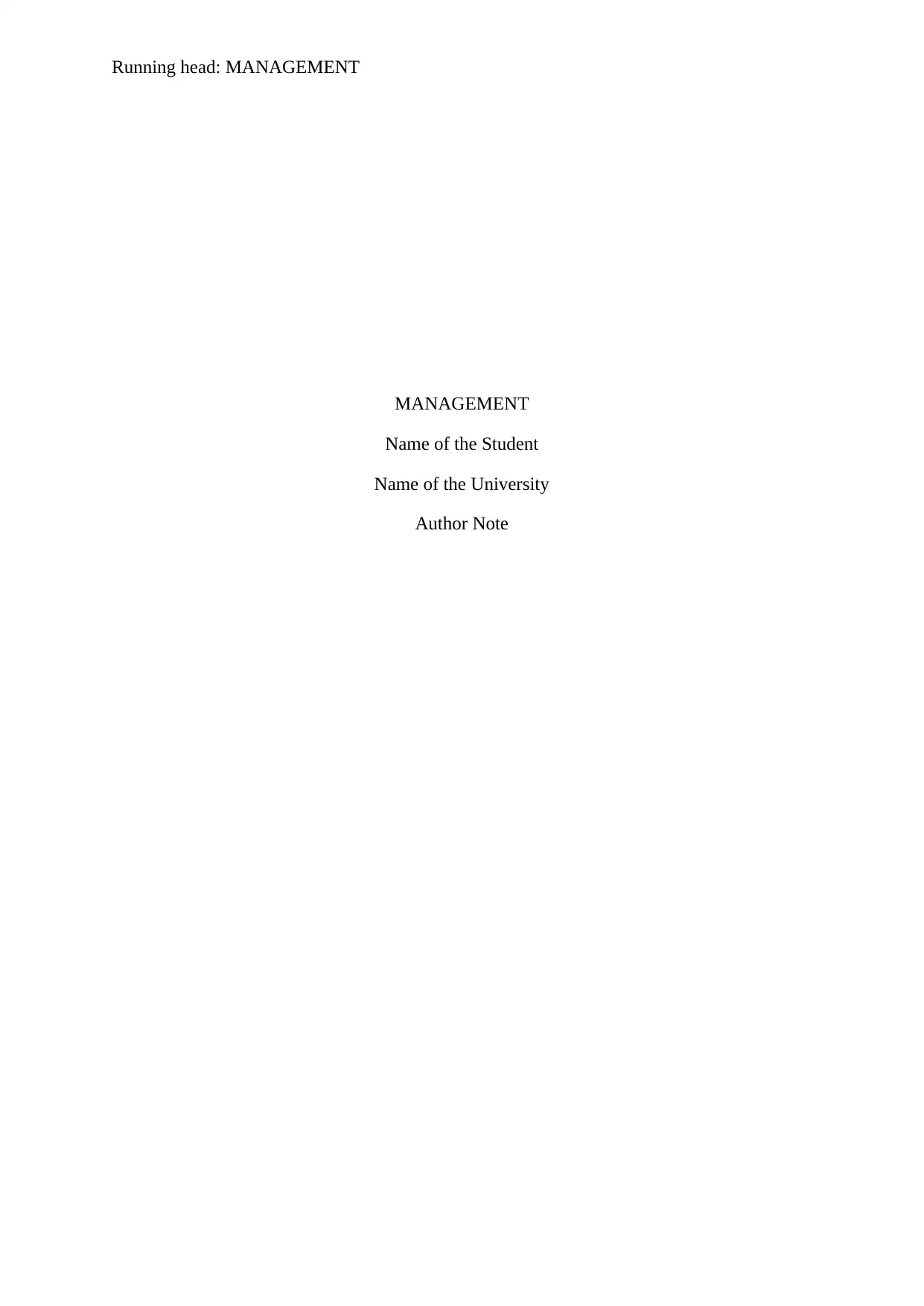
Running head: MANAGEMENT
MANAGEMENT
Name of the Student
Name of the University
Author Note
MANAGEMENT
Name of the Student
Name of the University
Author Note
Paraphrase This Document
Need a fresh take? Get an instant paraphrase of this document with our AI Paraphraser
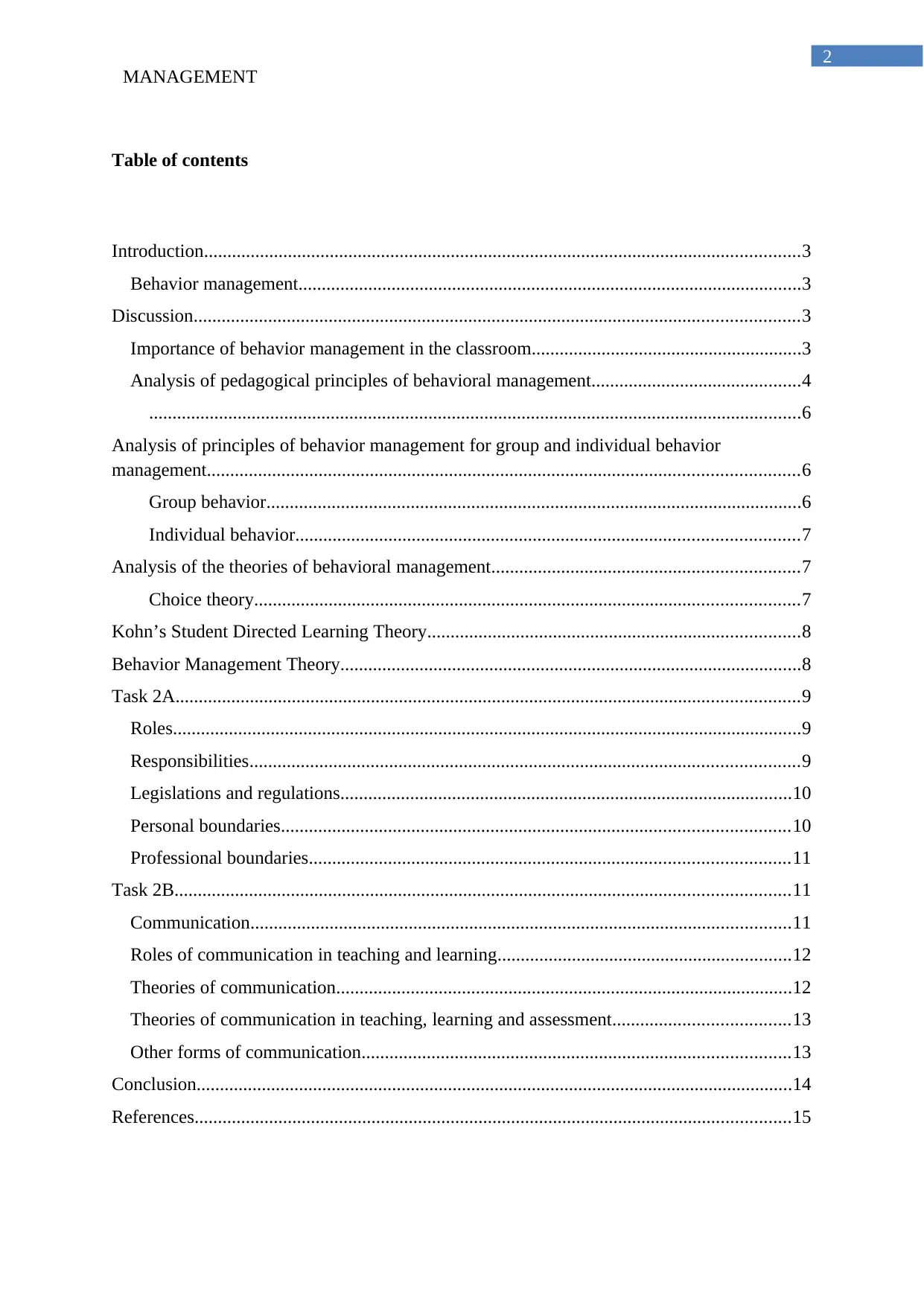
2
MANAGEMENT
Table of contents
Introduction................................................................................................................................3
Behavior management............................................................................................................3
Discussion..................................................................................................................................3
Importance of behavior management in the classroom..........................................................3
Analysis of pedagogical principles of behavioral management.............................................4
............................................................................................................................................6
Analysis of principles of behavior management for group and individual behavior
management...............................................................................................................................6
Group behavior...................................................................................................................6
Individual behavior............................................................................................................7
Analysis of the theories of behavioral management..................................................................7
Choice theory.....................................................................................................................7
Kohn’s Student Directed Learning Theory................................................................................8
Behavior Management Theory...................................................................................................8
Task 2A......................................................................................................................................9
Roles.......................................................................................................................................9
Responsibilities......................................................................................................................9
Legislations and regulations.................................................................................................10
Personal boundaries.............................................................................................................10
Professional boundaries.......................................................................................................11
Task 2B....................................................................................................................................11
Communication....................................................................................................................11
Roles of communication in teaching and learning...............................................................12
Theories of communication..................................................................................................12
Theories of communication in teaching, learning and assessment......................................13
Other forms of communication............................................................................................13
Conclusion................................................................................................................................14
References................................................................................................................................15
MANAGEMENT
Table of contents
Introduction................................................................................................................................3
Behavior management............................................................................................................3
Discussion..................................................................................................................................3
Importance of behavior management in the classroom..........................................................3
Analysis of pedagogical principles of behavioral management.............................................4
............................................................................................................................................6
Analysis of principles of behavior management for group and individual behavior
management...............................................................................................................................6
Group behavior...................................................................................................................6
Individual behavior............................................................................................................7
Analysis of the theories of behavioral management..................................................................7
Choice theory.....................................................................................................................7
Kohn’s Student Directed Learning Theory................................................................................8
Behavior Management Theory...................................................................................................8
Task 2A......................................................................................................................................9
Roles.......................................................................................................................................9
Responsibilities......................................................................................................................9
Legislations and regulations.................................................................................................10
Personal boundaries.............................................................................................................10
Professional boundaries.......................................................................................................11
Task 2B....................................................................................................................................11
Communication....................................................................................................................11
Roles of communication in teaching and learning...............................................................12
Theories of communication..................................................................................................12
Theories of communication in teaching, learning and assessment......................................13
Other forms of communication............................................................................................13
Conclusion................................................................................................................................14
References................................................................................................................................15
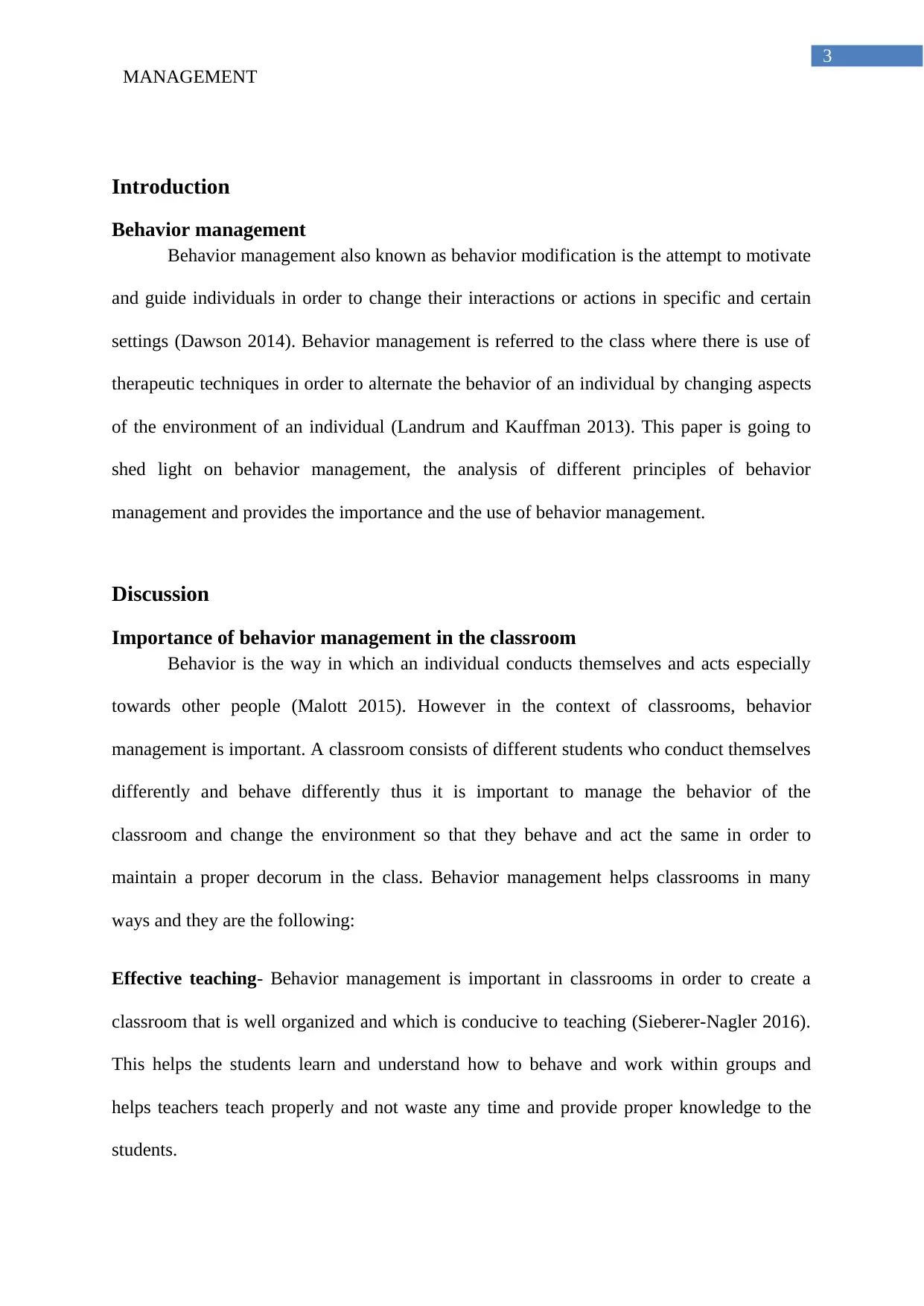
3
MANAGEMENT
Introduction
Behavior management
Behavior management also known as behavior modification is the attempt to motivate
and guide individuals in order to change their interactions or actions in specific and certain
settings (Dawson 2014). Behavior management is referred to the class where there is use of
therapeutic techniques in order to alternate the behavior of an individual by changing aspects
of the environment of an individual (Landrum and Kauffman 2013). This paper is going to
shed light on behavior management, the analysis of different principles of behavior
management and provides the importance and the use of behavior management.
Discussion
Importance of behavior management in the classroom
Behavior is the way in which an individual conducts themselves and acts especially
towards other people (Malott 2015). However in the context of classrooms, behavior
management is important. A classroom consists of different students who conduct themselves
differently and behave differently thus it is important to manage the behavior of the
classroom and change the environment so that they behave and act the same in order to
maintain a proper decorum in the class. Behavior management helps classrooms in many
ways and they are the following:
Effective teaching- Behavior management is important in classrooms in order to create a
classroom that is well organized and which is conducive to teaching (Sieberer-Nagler 2016).
This helps the students learn and understand how to behave and work within groups and
helps teachers teach properly and not waste any time and provide proper knowledge to the
students.
MANAGEMENT
Introduction
Behavior management
Behavior management also known as behavior modification is the attempt to motivate
and guide individuals in order to change their interactions or actions in specific and certain
settings (Dawson 2014). Behavior management is referred to the class where there is use of
therapeutic techniques in order to alternate the behavior of an individual by changing aspects
of the environment of an individual (Landrum and Kauffman 2013). This paper is going to
shed light on behavior management, the analysis of different principles of behavior
management and provides the importance and the use of behavior management.
Discussion
Importance of behavior management in the classroom
Behavior is the way in which an individual conducts themselves and acts especially
towards other people (Malott 2015). However in the context of classrooms, behavior
management is important. A classroom consists of different students who conduct themselves
differently and behave differently thus it is important to manage the behavior of the
classroom and change the environment so that they behave and act the same in order to
maintain a proper decorum in the class. Behavior management helps classrooms in many
ways and they are the following:
Effective teaching- Behavior management is important in classrooms in order to create a
classroom that is well organized and which is conducive to teaching (Sieberer-Nagler 2016).
This helps the students learn and understand how to behave and work within groups and
helps teachers teach properly and not waste any time and provide proper knowledge to the
students.
⊘ This is a preview!⊘
Do you want full access?
Subscribe today to unlock all pages.

Trusted by 1+ million students worldwide
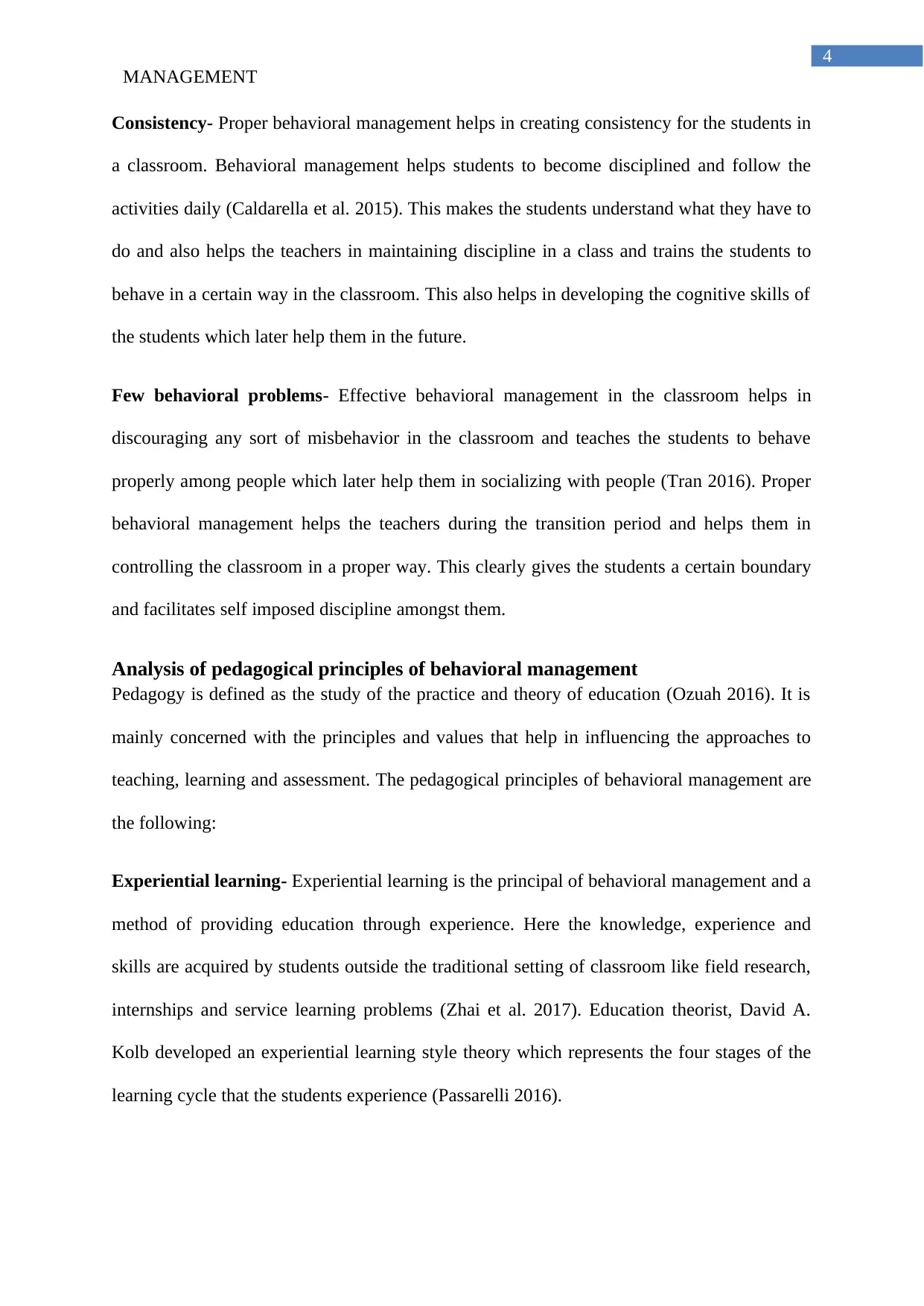
4
MANAGEMENT
Consistency- Proper behavioral management helps in creating consistency for the students in
a classroom. Behavioral management helps students to become disciplined and follow the
activities daily (Caldarella et al. 2015). This makes the students understand what they have to
do and also helps the teachers in maintaining discipline in a class and trains the students to
behave in a certain way in the classroom. This also helps in developing the cognitive skills of
the students which later help them in the future.
Few behavioral problems- Effective behavioral management in the classroom helps in
discouraging any sort of misbehavior in the classroom and teaches the students to behave
properly among people which later help them in socializing with people (Tran 2016). Proper
behavioral management helps the teachers during the transition period and helps them in
controlling the classroom in a proper way. This clearly gives the students a certain boundary
and facilitates self imposed discipline amongst them.
Analysis of pedagogical principles of behavioral management
Pedagogy is defined as the study of the practice and theory of education (Ozuah 2016). It is
mainly concerned with the principles and values that help in influencing the approaches to
teaching, learning and assessment. The pedagogical principles of behavioral management are
the following:
Experiential learning- Experiential learning is the principal of behavioral management and a
method of providing education through experience. Here the knowledge, experience and
skills are acquired by students outside the traditional setting of classroom like field research,
internships and service learning problems (Zhai et al. 2017). Education theorist, David A.
Kolb developed an experiential learning style theory which represents the four stages of the
learning cycle that the students experience (Passarelli 2016).
MANAGEMENT
Consistency- Proper behavioral management helps in creating consistency for the students in
a classroom. Behavioral management helps students to become disciplined and follow the
activities daily (Caldarella et al. 2015). This makes the students understand what they have to
do and also helps the teachers in maintaining discipline in a class and trains the students to
behave in a certain way in the classroom. This also helps in developing the cognitive skills of
the students which later help them in the future.
Few behavioral problems- Effective behavioral management in the classroom helps in
discouraging any sort of misbehavior in the classroom and teaches the students to behave
properly among people which later help them in socializing with people (Tran 2016). Proper
behavioral management helps the teachers during the transition period and helps them in
controlling the classroom in a proper way. This clearly gives the students a certain boundary
and facilitates self imposed discipline amongst them.
Analysis of pedagogical principles of behavioral management
Pedagogy is defined as the study of the practice and theory of education (Ozuah 2016). It is
mainly concerned with the principles and values that help in influencing the approaches to
teaching, learning and assessment. The pedagogical principles of behavioral management are
the following:
Experiential learning- Experiential learning is the principal of behavioral management and a
method of providing education through experience. Here the knowledge, experience and
skills are acquired by students outside the traditional setting of classroom like field research,
internships and service learning problems (Zhai et al. 2017). Education theorist, David A.
Kolb developed an experiential learning style theory which represents the four stages of the
learning cycle that the students experience (Passarelli 2016).
Paraphrase This Document
Need a fresh take? Get an instant paraphrase of this document with our AI Paraphraser
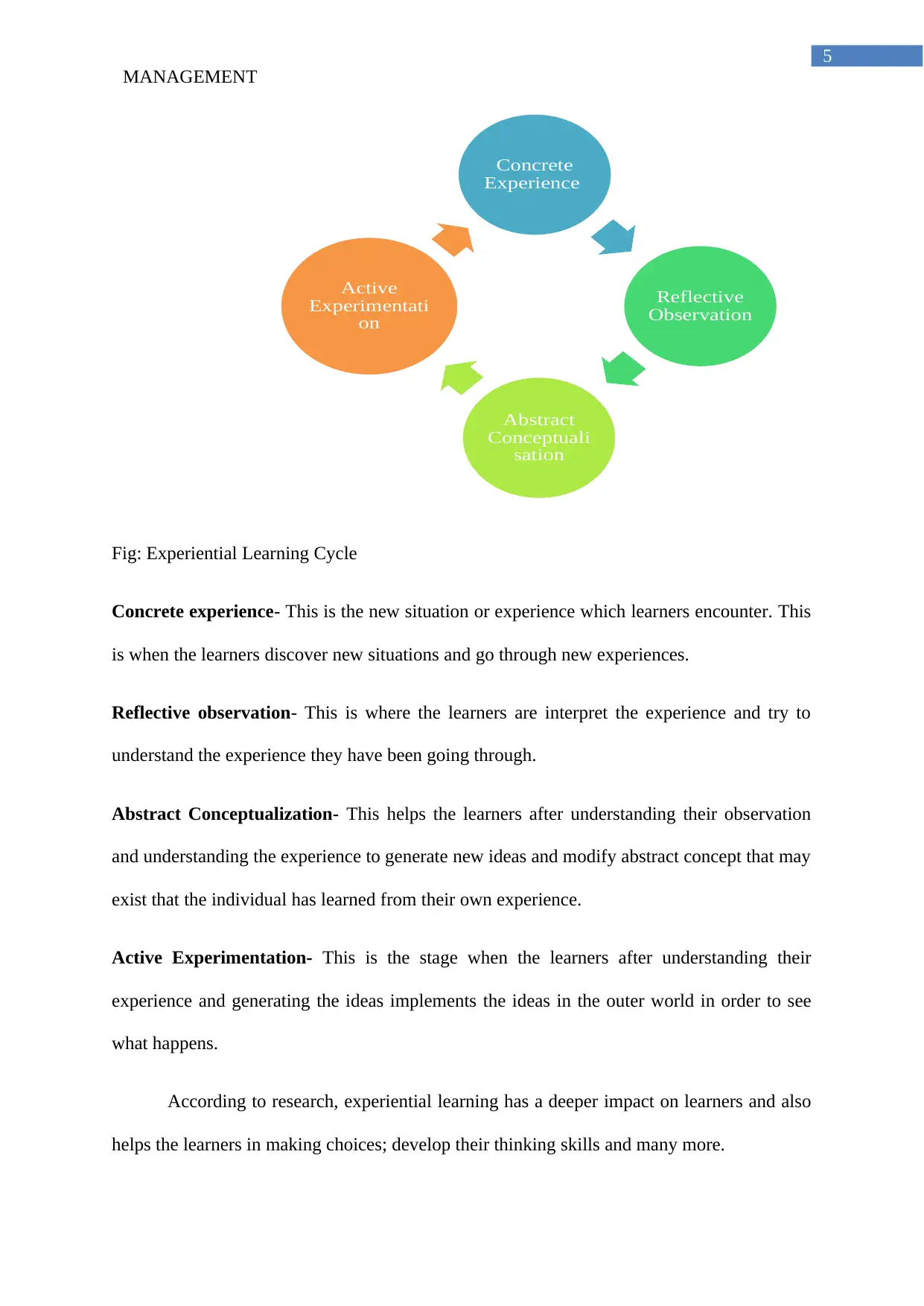
5
MANAGEMENT
Fig: Experiential Learning Cycle
Concrete experience- This is the new situation or experience which learners encounter. This
is when the learners discover new situations and go through new experiences.
Reflective observation- This is where the learners are interpret the experience and try to
understand the experience they have been going through.
Abstract Conceptualization- This helps the learners after understanding their observation
and understanding the experience to generate new ideas and modify abstract concept that may
exist that the individual has learned from their own experience.
Active Experimentation- This is the stage when the learners after understanding their
experience and generating the ideas implements the ideas in the outer world in order to see
what happens.
According to research, experiential learning has a deeper impact on learners and also
helps the learners in making choices; develop their thinking skills and many more.
Concrete
Experience
Reflective
Observation
Abstract
Conceptuali
sation
Active
Experimentati
on
MANAGEMENT
Fig: Experiential Learning Cycle
Concrete experience- This is the new situation or experience which learners encounter. This
is when the learners discover new situations and go through new experiences.
Reflective observation- This is where the learners are interpret the experience and try to
understand the experience they have been going through.
Abstract Conceptualization- This helps the learners after understanding their observation
and understanding the experience to generate new ideas and modify abstract concept that may
exist that the individual has learned from their own experience.
Active Experimentation- This is the stage when the learners after understanding their
experience and generating the ideas implements the ideas in the outer world in order to see
what happens.
According to research, experiential learning has a deeper impact on learners and also
helps the learners in making choices; develop their thinking skills and many more.
Concrete
Experience
Reflective
Observation
Abstract
Conceptuali
sation
Active
Experimentati
on
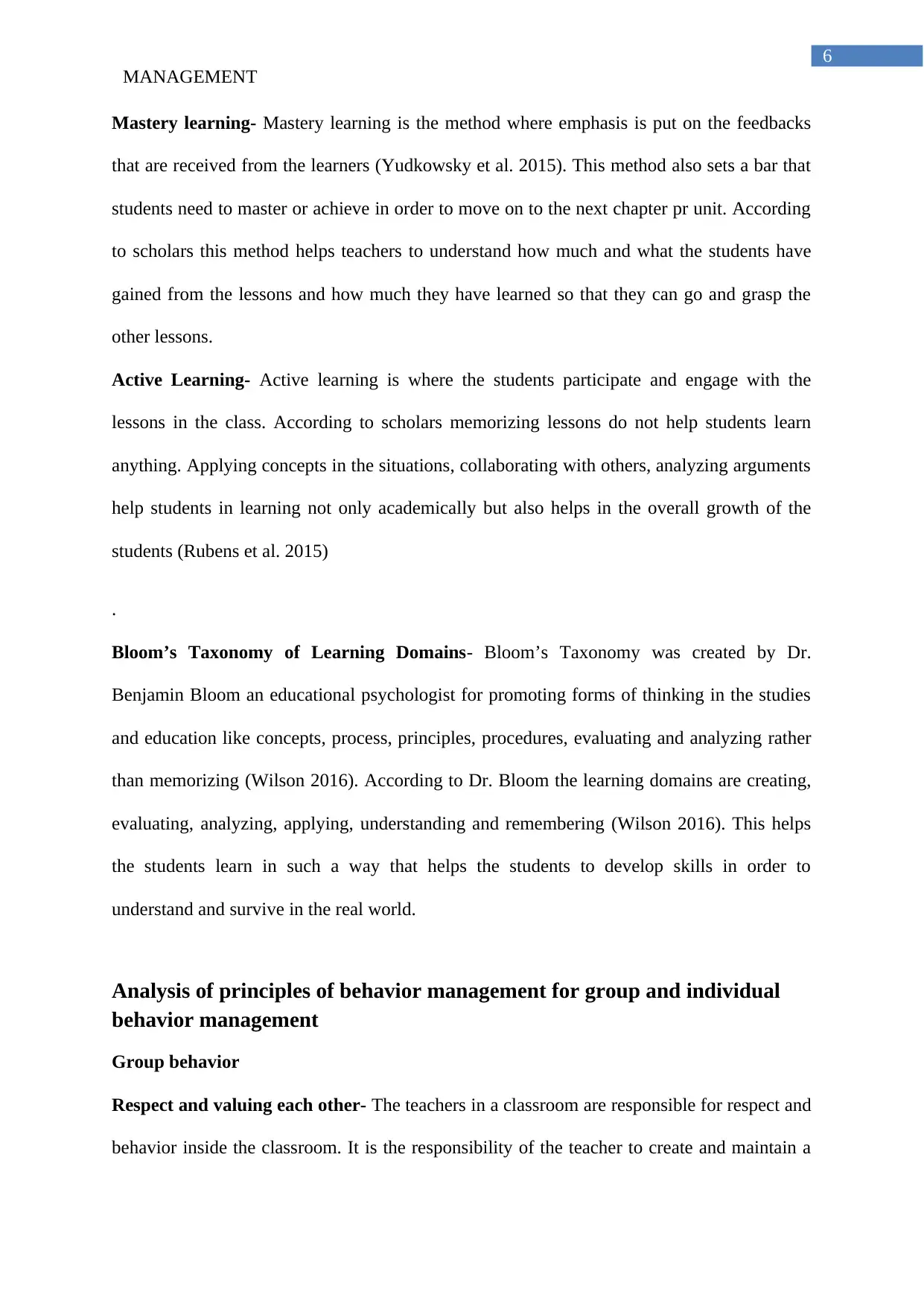
6
MANAGEMENT
Mastery learning- Mastery learning is the method where emphasis is put on the feedbacks
that are received from the learners (Yudkowsky et al. 2015). This method also sets a bar that
students need to master or achieve in order to move on to the next chapter pr unit. According
to scholars this method helps teachers to understand how much and what the students have
gained from the lessons and how much they have learned so that they can go and grasp the
other lessons.
Active Learning- Active learning is where the students participate and engage with the
lessons in the class. According to scholars memorizing lessons do not help students learn
anything. Applying concepts in the situations, collaborating with others, analyzing arguments
help students in learning not only academically but also helps in the overall growth of the
students (Rubens et al. 2015)
.
Bloom’s Taxonomy of Learning Domains- Bloom’s Taxonomy was created by Dr.
Benjamin Bloom an educational psychologist for promoting forms of thinking in the studies
and education like concepts, process, principles, procedures, evaluating and analyzing rather
than memorizing (Wilson 2016). According to Dr. Bloom the learning domains are creating,
evaluating, analyzing, applying, understanding and remembering (Wilson 2016). This helps
the students learn in such a way that helps the students to develop skills in order to
understand and survive in the real world.
Analysis of principles of behavior management for group and individual
behavior management
Group behavior
Respect and valuing each other- The teachers in a classroom are responsible for respect and
behavior inside the classroom. It is the responsibility of the teacher to create and maintain a
MANAGEMENT
Mastery learning- Mastery learning is the method where emphasis is put on the feedbacks
that are received from the learners (Yudkowsky et al. 2015). This method also sets a bar that
students need to master or achieve in order to move on to the next chapter pr unit. According
to scholars this method helps teachers to understand how much and what the students have
gained from the lessons and how much they have learned so that they can go and grasp the
other lessons.
Active Learning- Active learning is where the students participate and engage with the
lessons in the class. According to scholars memorizing lessons do not help students learn
anything. Applying concepts in the situations, collaborating with others, analyzing arguments
help students in learning not only academically but also helps in the overall growth of the
students (Rubens et al. 2015)
.
Bloom’s Taxonomy of Learning Domains- Bloom’s Taxonomy was created by Dr.
Benjamin Bloom an educational psychologist for promoting forms of thinking in the studies
and education like concepts, process, principles, procedures, evaluating and analyzing rather
than memorizing (Wilson 2016). According to Dr. Bloom the learning domains are creating,
evaluating, analyzing, applying, understanding and remembering (Wilson 2016). This helps
the students learn in such a way that helps the students to develop skills in order to
understand and survive in the real world.
Analysis of principles of behavior management for group and individual
behavior management
Group behavior
Respect and valuing each other- The teachers in a classroom are responsible for respect and
behavior inside the classroom. It is the responsibility of the teacher to create and maintain a
⊘ This is a preview!⊘
Do you want full access?
Subscribe today to unlock all pages.

Trusted by 1+ million students worldwide
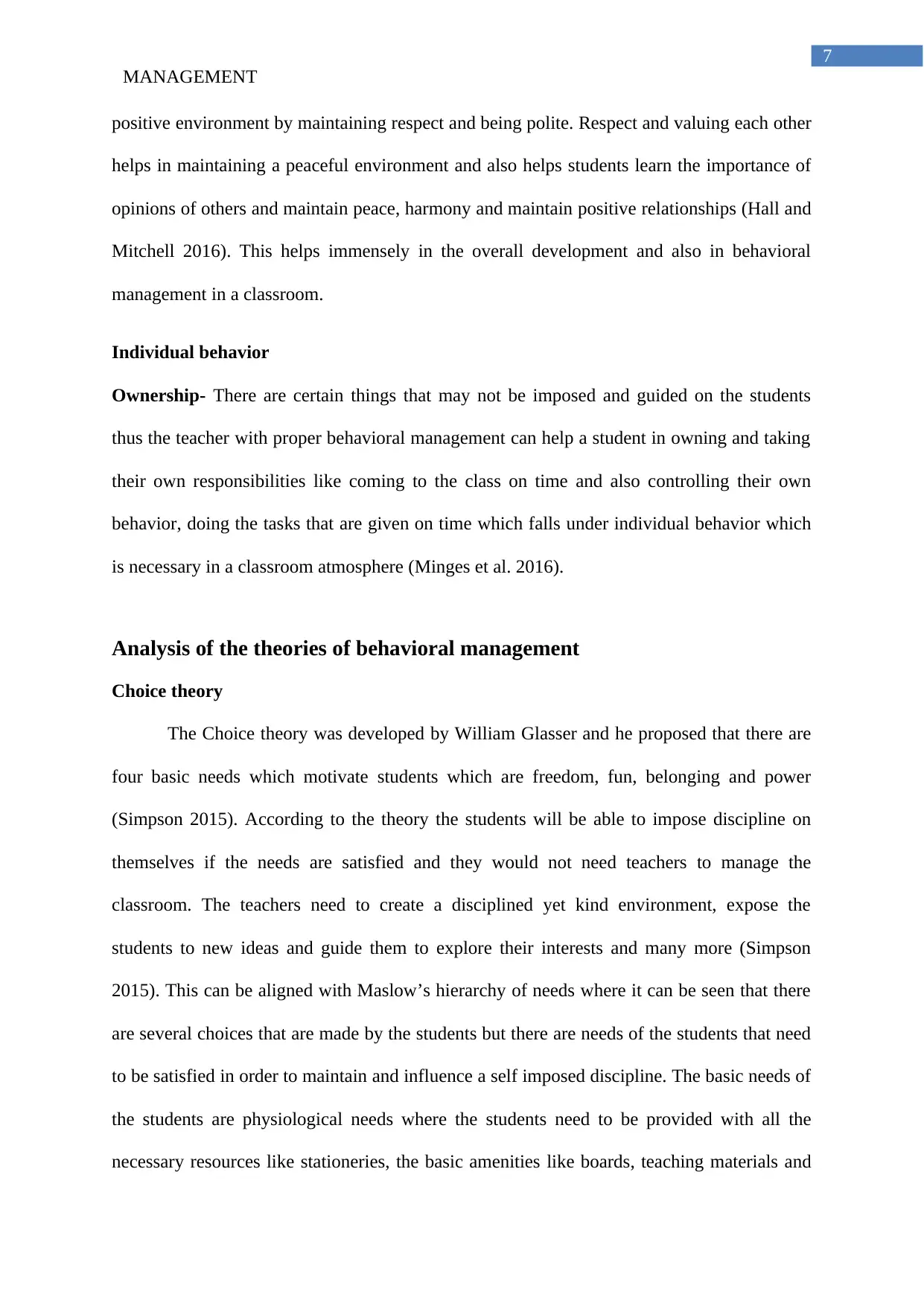
7
MANAGEMENT
positive environment by maintaining respect and being polite. Respect and valuing each other
helps in maintaining a peaceful environment and also helps students learn the importance of
opinions of others and maintain peace, harmony and maintain positive relationships (Hall and
Mitchell 2016). This helps immensely in the overall development and also in behavioral
management in a classroom.
Individual behavior
Ownership- There are certain things that may not be imposed and guided on the students
thus the teacher with proper behavioral management can help a student in owning and taking
their own responsibilities like coming to the class on time and also controlling their own
behavior, doing the tasks that are given on time which falls under individual behavior which
is necessary in a classroom atmosphere (Minges et al. 2016).
Analysis of the theories of behavioral management
Choice theory
The Choice theory was developed by William Glasser and he proposed that there are
four basic needs which motivate students which are freedom, fun, belonging and power
(Simpson 2015). According to the theory the students will be able to impose discipline on
themselves if the needs are satisfied and they would not need teachers to manage the
classroom. The teachers need to create a disciplined yet kind environment, expose the
students to new ideas and guide them to explore their interests and many more (Simpson
2015). This can be aligned with Maslow’s hierarchy of needs where it can be seen that there
are several choices that are made by the students but there are needs of the students that need
to be satisfied in order to maintain and influence a self imposed discipline. The basic needs of
the students are physiological needs where the students need to be provided with all the
necessary resources like stationeries, the basic amenities like boards, teaching materials and
MANAGEMENT
positive environment by maintaining respect and being polite. Respect and valuing each other
helps in maintaining a peaceful environment and also helps students learn the importance of
opinions of others and maintain peace, harmony and maintain positive relationships (Hall and
Mitchell 2016). This helps immensely in the overall development and also in behavioral
management in a classroom.
Individual behavior
Ownership- There are certain things that may not be imposed and guided on the students
thus the teacher with proper behavioral management can help a student in owning and taking
their own responsibilities like coming to the class on time and also controlling their own
behavior, doing the tasks that are given on time which falls under individual behavior which
is necessary in a classroom atmosphere (Minges et al. 2016).
Analysis of the theories of behavioral management
Choice theory
The Choice theory was developed by William Glasser and he proposed that there are
four basic needs which motivate students which are freedom, fun, belonging and power
(Simpson 2015). According to the theory the students will be able to impose discipline on
themselves if the needs are satisfied and they would not need teachers to manage the
classroom. The teachers need to create a disciplined yet kind environment, expose the
students to new ideas and guide them to explore their interests and many more (Simpson
2015). This can be aligned with Maslow’s hierarchy of needs where it can be seen that there
are several choices that are made by the students but there are needs of the students that need
to be satisfied in order to maintain and influence a self imposed discipline. The basic needs of
the students are physiological needs where the students need to be provided with all the
necessary resources like stationeries, the basic amenities like boards, teaching materials and
Paraphrase This Document
Need a fresh take? Get an instant paraphrase of this document with our AI Paraphraser
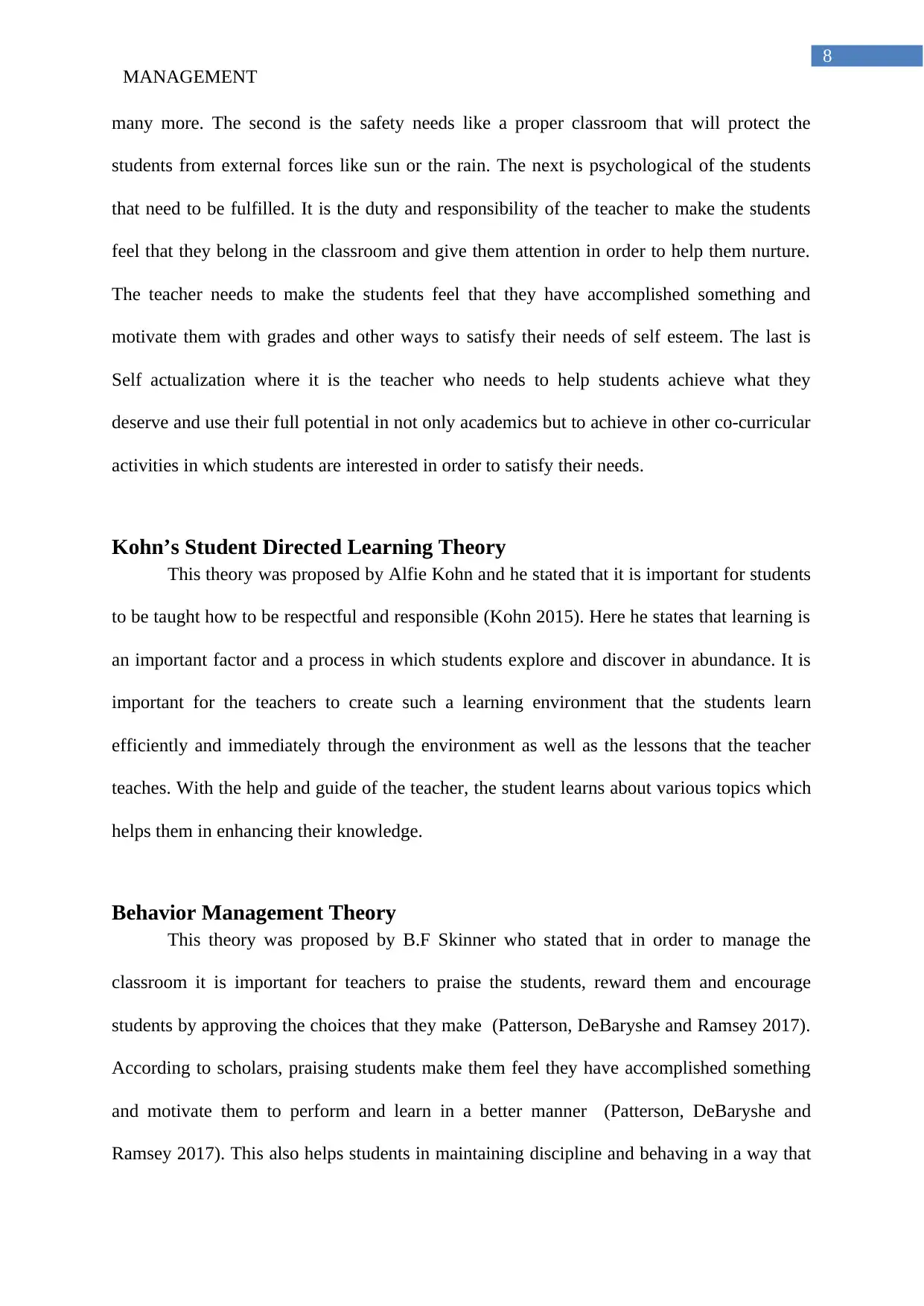
8
MANAGEMENT
many more. The second is the safety needs like a proper classroom that will protect the
students from external forces like sun or the rain. The next is psychological of the students
that need to be fulfilled. It is the duty and responsibility of the teacher to make the students
feel that they belong in the classroom and give them attention in order to help them nurture.
The teacher needs to make the students feel that they have accomplished something and
motivate them with grades and other ways to satisfy their needs of self esteem. The last is
Self actualization where it is the teacher who needs to help students achieve what they
deserve and use their full potential in not only academics but to achieve in other co-curricular
activities in which students are interested in order to satisfy their needs.
Kohn’s Student Directed Learning Theory
This theory was proposed by Alfie Kohn and he stated that it is important for students
to be taught how to be respectful and responsible (Kohn 2015). Here he states that learning is
an important factor and a process in which students explore and discover in abundance. It is
important for the teachers to create such a learning environment that the students learn
efficiently and immediately through the environment as well as the lessons that the teacher
teaches. With the help and guide of the teacher, the student learns about various topics which
helps them in enhancing their knowledge.
Behavior Management Theory
This theory was proposed by B.F Skinner who stated that in order to manage the
classroom it is important for teachers to praise the students, reward them and encourage
students by approving the choices that they make (Patterson, DeBaryshe and Ramsey 2017).
According to scholars, praising students make them feel they have accomplished something
and motivate them to perform and learn in a better manner (Patterson, DeBaryshe and
Ramsey 2017). This also helps students in maintaining discipline and behaving in a way that
MANAGEMENT
many more. The second is the safety needs like a proper classroom that will protect the
students from external forces like sun or the rain. The next is psychological of the students
that need to be fulfilled. It is the duty and responsibility of the teacher to make the students
feel that they belong in the classroom and give them attention in order to help them nurture.
The teacher needs to make the students feel that they have accomplished something and
motivate them with grades and other ways to satisfy their needs of self esteem. The last is
Self actualization where it is the teacher who needs to help students achieve what they
deserve and use their full potential in not only academics but to achieve in other co-curricular
activities in which students are interested in order to satisfy their needs.
Kohn’s Student Directed Learning Theory
This theory was proposed by Alfie Kohn and he stated that it is important for students
to be taught how to be respectful and responsible (Kohn 2015). Here he states that learning is
an important factor and a process in which students explore and discover in abundance. It is
important for the teachers to create such a learning environment that the students learn
efficiently and immediately through the environment as well as the lessons that the teacher
teaches. With the help and guide of the teacher, the student learns about various topics which
helps them in enhancing their knowledge.
Behavior Management Theory
This theory was proposed by B.F Skinner who stated that in order to manage the
classroom it is important for teachers to praise the students, reward them and encourage
students by approving the choices that they make (Patterson, DeBaryshe and Ramsey 2017).
According to scholars, praising students make them feel they have accomplished something
and motivate them to perform and learn in a better manner (Patterson, DeBaryshe and
Ramsey 2017). This also helps students in maintaining discipline and behaving in a way that
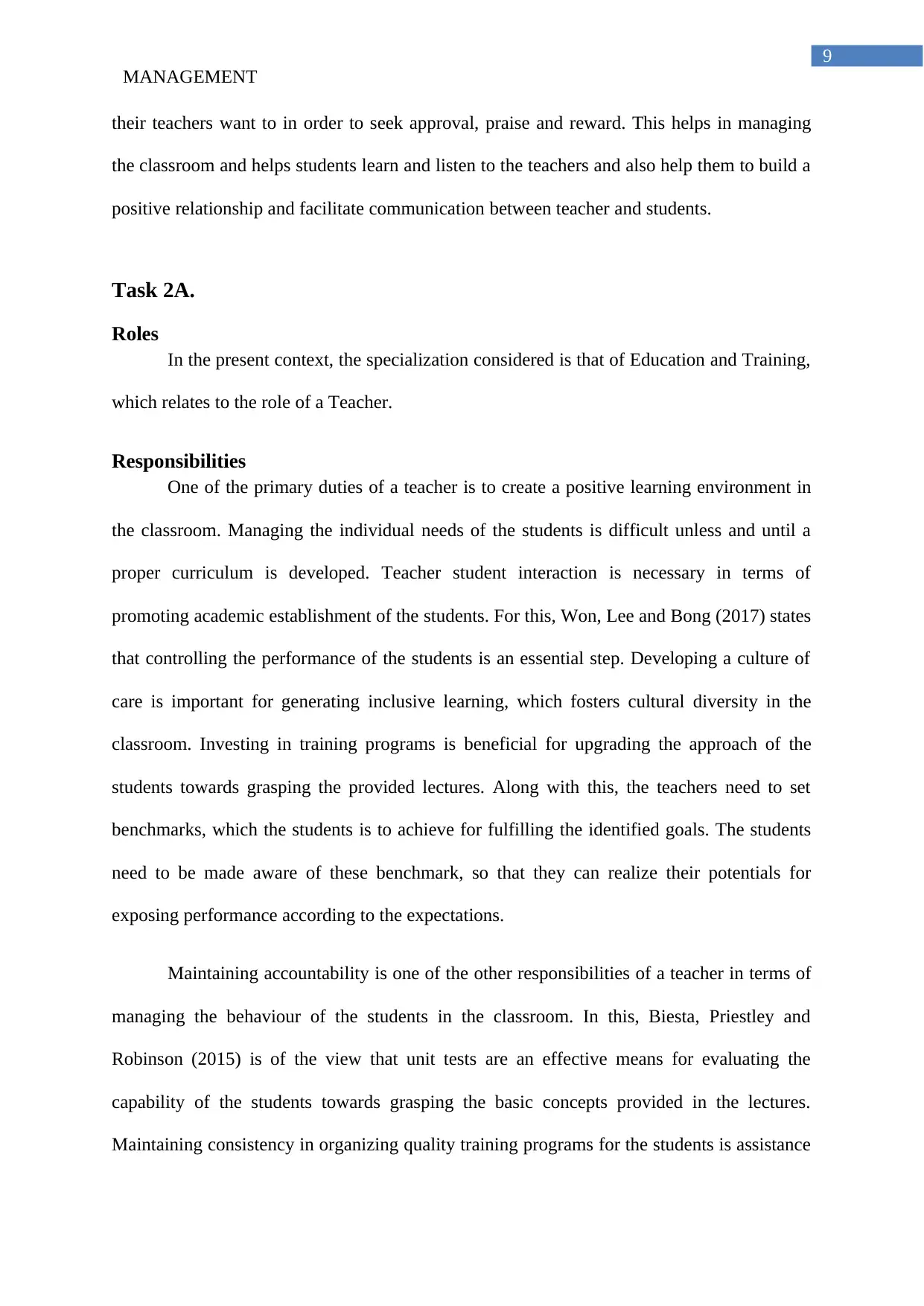
9
MANAGEMENT
their teachers want to in order to seek approval, praise and reward. This helps in managing
the classroom and helps students learn and listen to the teachers and also help them to build a
positive relationship and facilitate communication between teacher and students.
Task 2A.
Roles
In the present context, the specialization considered is that of Education and Training,
which relates to the role of a Teacher.
Responsibilities
One of the primary duties of a teacher is to create a positive learning environment in
the classroom. Managing the individual needs of the students is difficult unless and until a
proper curriculum is developed. Teacher student interaction is necessary in terms of
promoting academic establishment of the students. For this, Won, Lee and Bong (2017) states
that controlling the performance of the students is an essential step. Developing a culture of
care is important for generating inclusive learning, which fosters cultural diversity in the
classroom. Investing in training programs is beneficial for upgrading the approach of the
students towards grasping the provided lectures. Along with this, the teachers need to set
benchmarks, which the students is to achieve for fulfilling the identified goals. The students
need to be made aware of these benchmark, so that they can realize their potentials for
exposing performance according to the expectations.
Maintaining accountability is one of the other responsibilities of a teacher in terms of
managing the behaviour of the students in the classroom. In this, Biesta, Priestley and
Robinson (2015) is of the view that unit tests are an effective means for evaluating the
capability of the students towards grasping the basic concepts provided in the lectures.
Maintaining consistency in organizing quality training programs for the students is assistance
MANAGEMENT
their teachers want to in order to seek approval, praise and reward. This helps in managing
the classroom and helps students learn and listen to the teachers and also help them to build a
positive relationship and facilitate communication between teacher and students.
Task 2A.
Roles
In the present context, the specialization considered is that of Education and Training,
which relates to the role of a Teacher.
Responsibilities
One of the primary duties of a teacher is to create a positive learning environment in
the classroom. Managing the individual needs of the students is difficult unless and until a
proper curriculum is developed. Teacher student interaction is necessary in terms of
promoting academic establishment of the students. For this, Won, Lee and Bong (2017) states
that controlling the performance of the students is an essential step. Developing a culture of
care is important for generating inclusive learning, which fosters cultural diversity in the
classroom. Investing in training programs is beneficial for upgrading the approach of the
students towards grasping the provided lectures. Along with this, the teachers need to set
benchmarks, which the students is to achieve for fulfilling the identified goals. The students
need to be made aware of these benchmark, so that they can realize their potentials for
exposing performance according to the expectations.
Maintaining accountability is one of the other responsibilities of a teacher in terms of
managing the behaviour of the students in the classroom. In this, Biesta, Priestley and
Robinson (2015) is of the view that unit tests are an effective means for evaluating the
capability of the students towards grasping the basic concepts provided in the lectures.
Maintaining consistency in organizing quality training programs for the students is assistance
⊘ This is a preview!⊘
Do you want full access?
Subscribe today to unlock all pages.

Trusted by 1+ million students worldwide
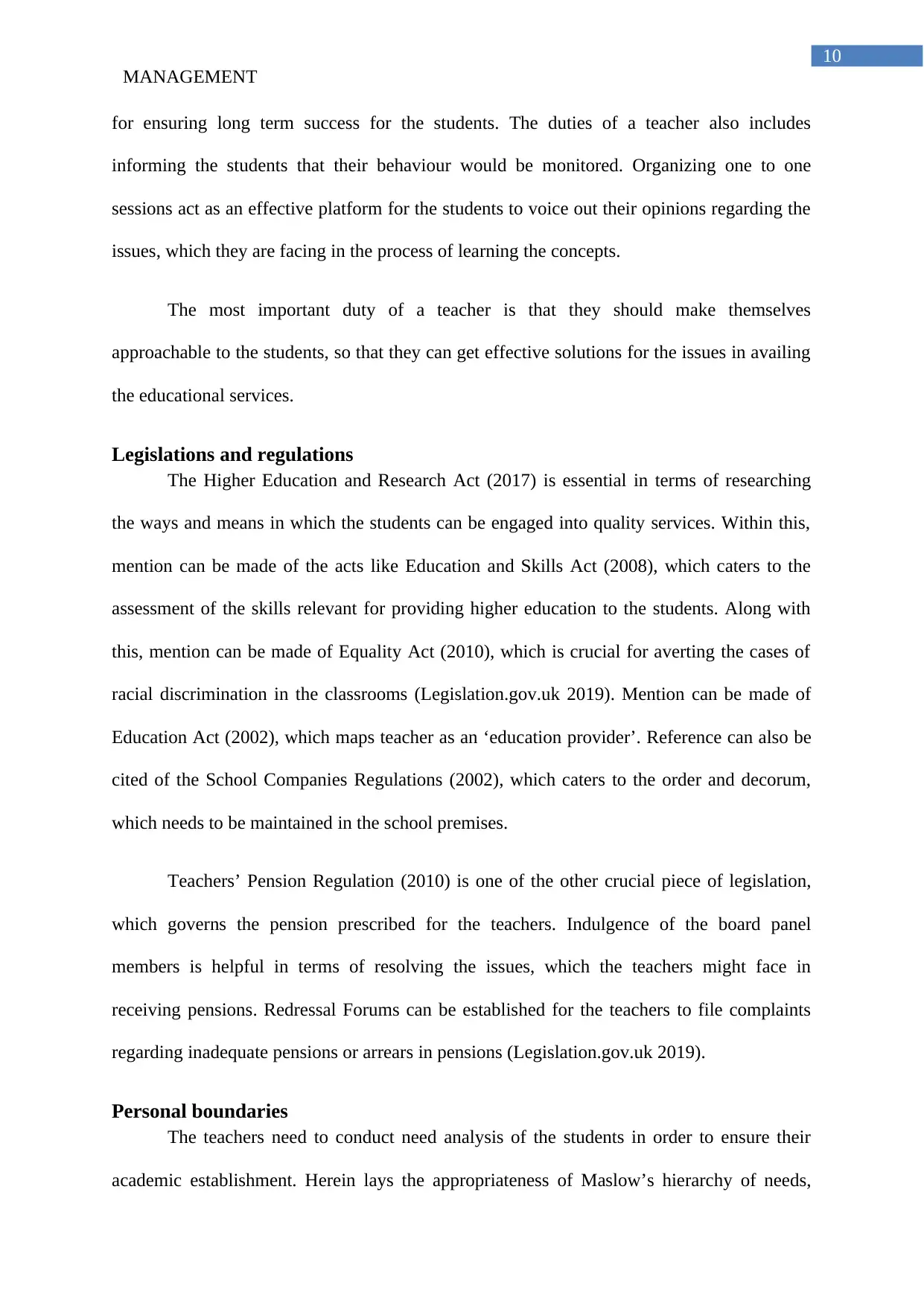
10
MANAGEMENT
for ensuring long term success for the students. The duties of a teacher also includes
informing the students that their behaviour would be monitored. Organizing one to one
sessions act as an effective platform for the students to voice out their opinions regarding the
issues, which they are facing in the process of learning the concepts.
The most important duty of a teacher is that they should make themselves
approachable to the students, so that they can get effective solutions for the issues in availing
the educational services.
Legislations and regulations
The Higher Education and Research Act (2017) is essential in terms of researching
the ways and means in which the students can be engaged into quality services. Within this,
mention can be made of the acts like Education and Skills Act (2008), which caters to the
assessment of the skills relevant for providing higher education to the students. Along with
this, mention can be made of Equality Act (2010), which is crucial for averting the cases of
racial discrimination in the classrooms (Legislation.gov.uk 2019). Mention can be made of
Education Act (2002), which maps teacher as an ‘education provider’. Reference can also be
cited of the School Companies Regulations (2002), which caters to the order and decorum,
which needs to be maintained in the school premises.
Teachers’ Pension Regulation (2010) is one of the other crucial piece of legislation,
which governs the pension prescribed for the teachers. Indulgence of the board panel
members is helpful in terms of resolving the issues, which the teachers might face in
receiving pensions. Redressal Forums can be established for the teachers to file complaints
regarding inadequate pensions or arrears in pensions (Legislation.gov.uk 2019).
Personal boundaries
The teachers need to conduct need analysis of the students in order to ensure their
academic establishment. Herein lays the appropriateness of Maslow’s hierarchy of needs,
MANAGEMENT
for ensuring long term success for the students. The duties of a teacher also includes
informing the students that their behaviour would be monitored. Organizing one to one
sessions act as an effective platform for the students to voice out their opinions regarding the
issues, which they are facing in the process of learning the concepts.
The most important duty of a teacher is that they should make themselves
approachable to the students, so that they can get effective solutions for the issues in availing
the educational services.
Legislations and regulations
The Higher Education and Research Act (2017) is essential in terms of researching
the ways and means in which the students can be engaged into quality services. Within this,
mention can be made of the acts like Education and Skills Act (2008), which caters to the
assessment of the skills relevant for providing higher education to the students. Along with
this, mention can be made of Equality Act (2010), which is crucial for averting the cases of
racial discrimination in the classrooms (Legislation.gov.uk 2019). Mention can be made of
Education Act (2002), which maps teacher as an ‘education provider’. Reference can also be
cited of the School Companies Regulations (2002), which caters to the order and decorum,
which needs to be maintained in the school premises.
Teachers’ Pension Regulation (2010) is one of the other crucial piece of legislation,
which governs the pension prescribed for the teachers. Indulgence of the board panel
members is helpful in terms of resolving the issues, which the teachers might face in
receiving pensions. Redressal Forums can be established for the teachers to file complaints
regarding inadequate pensions or arrears in pensions (Legislation.gov.uk 2019).
Personal boundaries
The teachers need to conduct need analysis of the students in order to ensure their
academic establishment. Herein lays the appropriateness of Maslow’s hierarchy of needs,
Paraphrase This Document
Need a fresh take? Get an instant paraphrase of this document with our AI Paraphraser
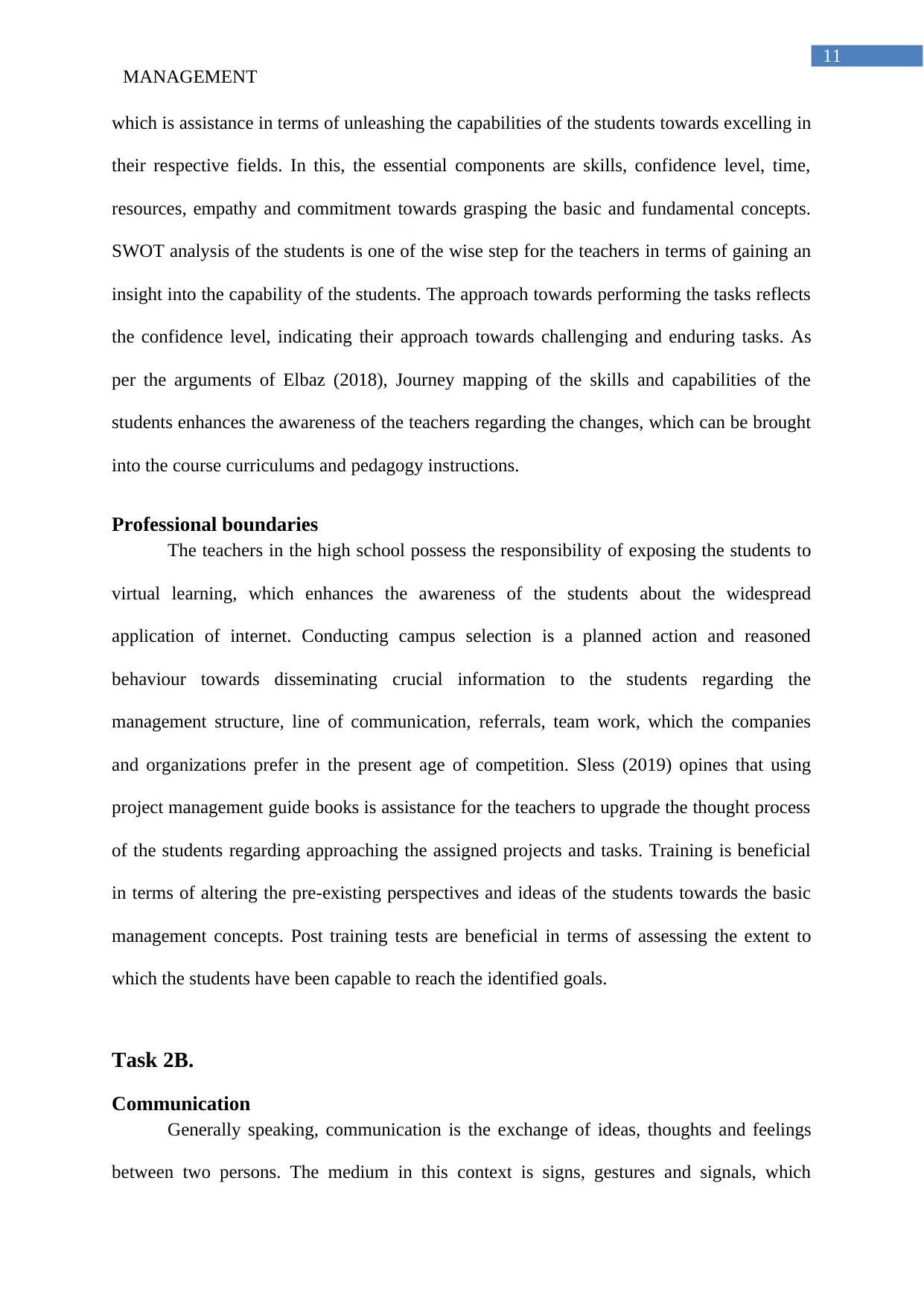
11
MANAGEMENT
which is assistance in terms of unleashing the capabilities of the students towards excelling in
their respective fields. In this, the essential components are skills, confidence level, time,
resources, empathy and commitment towards grasping the basic and fundamental concepts.
SWOT analysis of the students is one of the wise step for the teachers in terms of gaining an
insight into the capability of the students. The approach towards performing the tasks reflects
the confidence level, indicating their approach towards challenging and enduring tasks. As
per the arguments of Elbaz (2018), Journey mapping of the skills and capabilities of the
students enhances the awareness of the teachers regarding the changes, which can be brought
into the course curriculums and pedagogy instructions.
Professional boundaries
The teachers in the high school possess the responsibility of exposing the students to
virtual learning, which enhances the awareness of the students about the widespread
application of internet. Conducting campus selection is a planned action and reasoned
behaviour towards disseminating crucial information to the students regarding the
management structure, line of communication, referrals, team work, which the companies
and organizations prefer in the present age of competition. Sless (2019) opines that using
project management guide books is assistance for the teachers to upgrade the thought process
of the students regarding approaching the assigned projects and tasks. Training is beneficial
in terms of altering the pre-existing perspectives and ideas of the students towards the basic
management concepts. Post training tests are beneficial in terms of assessing the extent to
which the students have been capable to reach the identified goals.
Task 2B.
Communication
Generally speaking, communication is the exchange of ideas, thoughts and feelings
between two persons. The medium in this context is signs, gestures and signals, which
MANAGEMENT
which is assistance in terms of unleashing the capabilities of the students towards excelling in
their respective fields. In this, the essential components are skills, confidence level, time,
resources, empathy and commitment towards grasping the basic and fundamental concepts.
SWOT analysis of the students is one of the wise step for the teachers in terms of gaining an
insight into the capability of the students. The approach towards performing the tasks reflects
the confidence level, indicating their approach towards challenging and enduring tasks. As
per the arguments of Elbaz (2018), Journey mapping of the skills and capabilities of the
students enhances the awareness of the teachers regarding the changes, which can be brought
into the course curriculums and pedagogy instructions.
Professional boundaries
The teachers in the high school possess the responsibility of exposing the students to
virtual learning, which enhances the awareness of the students about the widespread
application of internet. Conducting campus selection is a planned action and reasoned
behaviour towards disseminating crucial information to the students regarding the
management structure, line of communication, referrals, team work, which the companies
and organizations prefer in the present age of competition. Sless (2019) opines that using
project management guide books is assistance for the teachers to upgrade the thought process
of the students regarding approaching the assigned projects and tasks. Training is beneficial
in terms of altering the pre-existing perspectives and ideas of the students towards the basic
management concepts. Post training tests are beneficial in terms of assessing the extent to
which the students have been capable to reach the identified goals.
Task 2B.
Communication
Generally speaking, communication is the exchange of ideas, thoughts and feelings
between two persons. The medium in this context is signs, gestures and signals, which
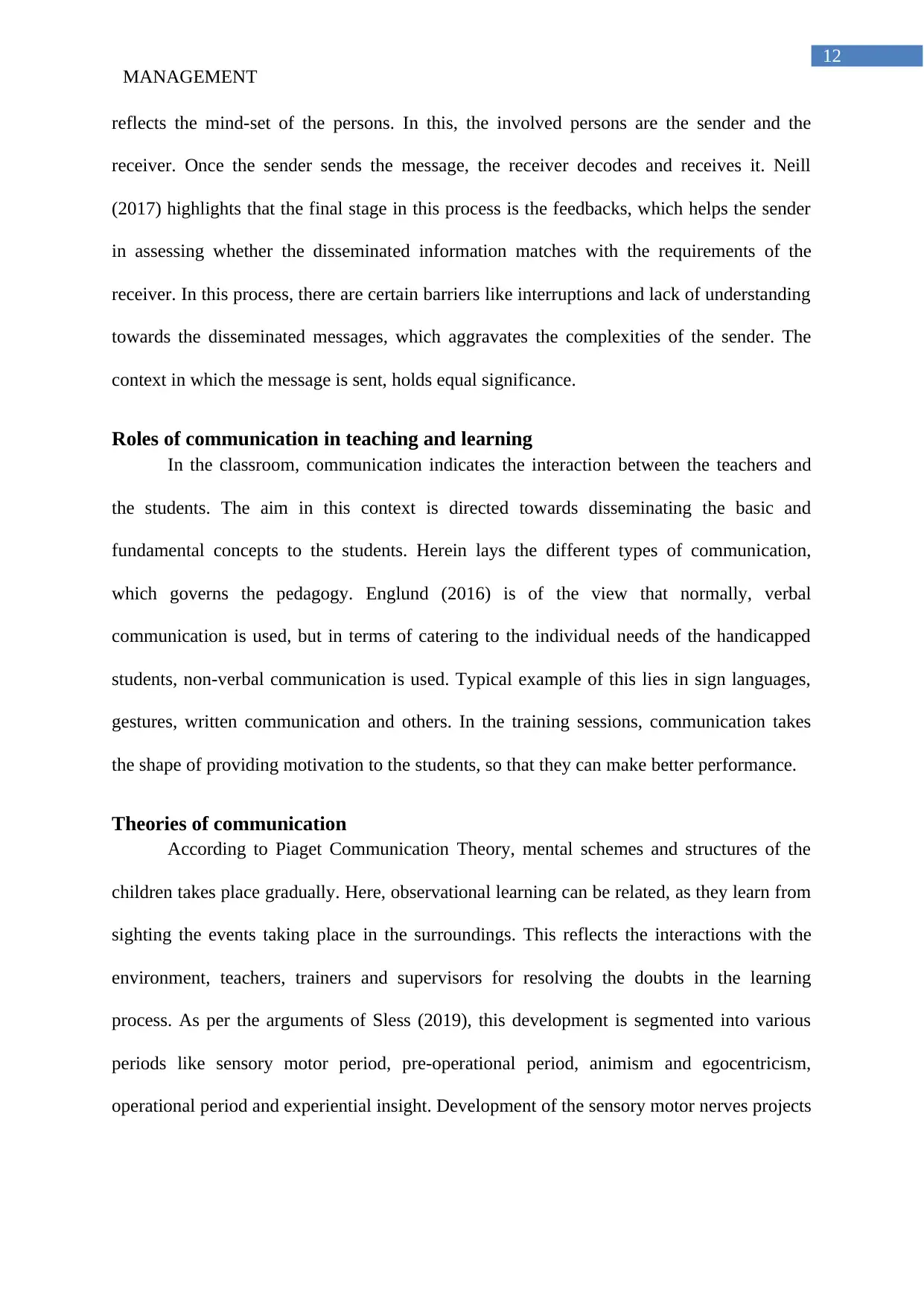
12
MANAGEMENT
reflects the mind-set of the persons. In this, the involved persons are the sender and the
receiver. Once the sender sends the message, the receiver decodes and receives it. Neill
(2017) highlights that the final stage in this process is the feedbacks, which helps the sender
in assessing whether the disseminated information matches with the requirements of the
receiver. In this process, there are certain barriers like interruptions and lack of understanding
towards the disseminated messages, which aggravates the complexities of the sender. The
context in which the message is sent, holds equal significance.
Roles of communication in teaching and learning
In the classroom, communication indicates the interaction between the teachers and
the students. The aim in this context is directed towards disseminating the basic and
fundamental concepts to the students. Herein lays the different types of communication,
which governs the pedagogy. Englund (2016) is of the view that normally, verbal
communication is used, but in terms of catering to the individual needs of the handicapped
students, non-verbal communication is used. Typical example of this lies in sign languages,
gestures, written communication and others. In the training sessions, communication takes
the shape of providing motivation to the students, so that they can make better performance.
Theories of communication
According to Piaget Communication Theory, mental schemes and structures of the
children takes place gradually. Here, observational learning can be related, as they learn from
sighting the events taking place in the surroundings. This reflects the interactions with the
environment, teachers, trainers and supervisors for resolving the doubts in the learning
process. As per the arguments of Sless (2019), this development is segmented into various
periods like sensory motor period, pre-operational period, animism and egocentricism,
operational period and experiential insight. Development of the sensory motor nerves projects
MANAGEMENT
reflects the mind-set of the persons. In this, the involved persons are the sender and the
receiver. Once the sender sends the message, the receiver decodes and receives it. Neill
(2017) highlights that the final stage in this process is the feedbacks, which helps the sender
in assessing whether the disseminated information matches with the requirements of the
receiver. In this process, there are certain barriers like interruptions and lack of understanding
towards the disseminated messages, which aggravates the complexities of the sender. The
context in which the message is sent, holds equal significance.
Roles of communication in teaching and learning
In the classroom, communication indicates the interaction between the teachers and
the students. The aim in this context is directed towards disseminating the basic and
fundamental concepts to the students. Herein lays the different types of communication,
which governs the pedagogy. Englund (2016) is of the view that normally, verbal
communication is used, but in terms of catering to the individual needs of the handicapped
students, non-verbal communication is used. Typical example of this lies in sign languages,
gestures, written communication and others. In the training sessions, communication takes
the shape of providing motivation to the students, so that they can make better performance.
Theories of communication
According to Piaget Communication Theory, mental schemes and structures of the
children takes place gradually. Here, observational learning can be related, as they learn from
sighting the events taking place in the surroundings. This reflects the interactions with the
environment, teachers, trainers and supervisors for resolving the doubts in the learning
process. As per the arguments of Sless (2019), this development is segmented into various
periods like sensory motor period, pre-operational period, animism and egocentricism,
operational period and experiential insight. Development of the sensory motor nerves projects
⊘ This is a preview!⊘
Do you want full access?
Subscribe today to unlock all pages.

Trusted by 1+ million students worldwide
1 out of 17
Related Documents
Your All-in-One AI-Powered Toolkit for Academic Success.
+13062052269
info@desklib.com
Available 24*7 on WhatsApp / Email
![[object Object]](/_next/static/media/star-bottom.7253800d.svg)
Unlock your academic potential
Copyright © 2020–2025 A2Z Services. All Rights Reserved. Developed and managed by ZUCOL.





